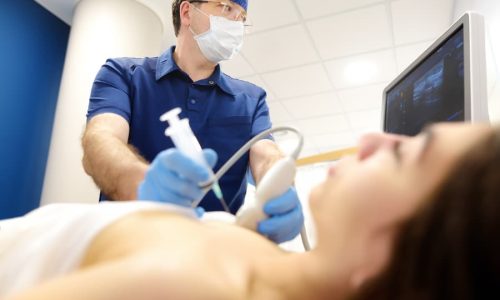
How Does Physical Therapy Help After a Mastectomy?
Physical therapy is well known for its role in helping patients recover from sports injuries, surgeries, and orthopedic conditions. Many people may not realize that
HIPAA Alert: Potential Data Breach Learn More
Questions on Oncology, Hematology and/or Infusion Clinical Services due to COVID-19 Crisis – CALL 833-698-1623
Important Information for Our Patients Regarding the Coronavirus.
RCCA Providing Area Cancer Patients with Access to Care During Coronavirus Outbreak
RCCA Offering Patients Virtual Visits During Coronavirus Pandemic
Early detection is essential to breast cancer treatment. The sooner cancer is diagnosed, the easier it will be to treat and avoid long-term health consequences. If a mammogram or other imaging test shows an abnormality, a breast biopsy will be recommended to confirm the diagnosis.
Following, we discuss breast biopsies and what to expect from testing.

A biopsy is a diagnostic procedure used to evaluate tissue for signs of disease. It involves removing a piece of tissue or small amount of fluid, called a sample, from the suspicious area that was identified during screening. This sample is then examined in a laboratory to look for cancer cells.
A breast biopsy can be done in one of several ways. The recommended method depends on factors including the size and location of the breast abnormality, whether there is more than one abnormality, the individual’s overall health, and more. Types of breast biopsies include:
After the tissue sample has been taken, it is sent to a medical laboratory. There, it will be tested by a pathologist who prepares a detailed report of the sample’s important characteristics.
Most breast biopsies do not find cancer. Breast tissues undergo many changes over time that are benign and no cause for concern. Other changes may require medical attention but aren’t cancer. The following biopsy report terms describe non-cancerous changes:
Many of these conditions do not need to be treated unless they are causing symptoms. Many of them also have no effect on the risk of developing future breast cancer. Individuals should speak with a healthcare provider about symptoms or any concerns regarding benign breast biopsy results.
If cancer cells were found in the biopsy sample, the pathology report will include additional information about the cancer’s characteristics. This information will help the cancer care team understand your condition better, allowing them to recommend the best treatment plan for you. Following are some terms you may see on your pathology report:
Noninvasive cancer cells are found only in the milk duct where they initially formed. They may also be described as ductal carcinoma in situ (DCIS). This is considered pre-cancer or stage 0 breast cancer. Invasive cancer cells, meanwhile, have spread to tissue near the milk duct or beyond the breast.
The biopsy report will also include the cancer’s grade. This is a numbered scale that describes a tumor’s size, shape, degree of abnormality, and growth rate. Cancer grade is a separate identifier from its stage but is used to determine the stage. Grades include:
Hormone receptors are special proteins found inside cells. They bind to certain hormones, provoking a response from the cell. Part of a breast cancer biopsy includes checking for hormone receptors that bind to estrogen or progesterone. If the tumor tests positive for either type of receptor, then it is using hormones to grow. This means hormone therapy may be an effective treatment.
On a biopsy pathology report, the word “negative” indicates that no hormone receptors are present. “Positive” indicates that there are receptors present. If the hormone receptor report is positive, it will also include the following information:
HER2 is a protein responsible for controlling breast growth. Some amount of HER2 protein is normal in healthy breasts. Certain types of cancer produce too much HER2, however, causing uncontrolled cell division and growth. By measuring the quantity of HER2 present in breast cancer, oncologists can determine what type of cancer is present and plan a more effective treatment.
Individuals may see the term “equivocal” on a pathology report. This indicates that the amount of HER2 is unclear. Second tests may be requested to determine a cancer’s HER2 status.
Finally, the pathology report will include the cancer’s stage. This is scaled from 0 to IV based on an overall understanding of the tumor and its behavior, including its grade, hormone receptor status, HER2 status, and how much cancer cells have spread. Higher stages indicate more serious cancers requiring more aggressive treatments.
In addition to stage, the biopsy report may also designate a special type of breast cancer. Types include:
A biopsy involves removing a small tissue sample for examination to confirm whether cells are cancerous. Breast biopsies are typically requested after a routine mammogram or other test detects a tissue abnormality in the breast. The biopsy helps medical oncologists come to a more conclusive diagnosis.
Along with a biopsy, breast cancer diagnosis usually involves a combination of a physical exam, mammography, ultrasound, and MRI.
Breast biopsies can provide information about whether a tumor is invasive, its grade, the presence of certain proteins, the stage of cancer, and the type of cancer.
Most biopsies do not identify cancer. The procedure can also be used to confirm that an abnormality is benign and may not need treatment.
Regional Cancer Care Associates specialists provide care to more than 30,000 new patients and 265,000 established patients each year. RCCA physicians offer patients innovative therapies, including immunotherapies and targeted therapy, cutting-edge diagnostics as well as access to approximately 300 clinical trials in community-based centers close to home.
RCCA includes more than 100 medical oncologists and hematologists who treat patients who have solid tumors, blood-based cancers and benign blood disorders at 25 locations throughout New Jersey, Connecticut, Massachusetts, and the Washington, D.C., area. RCCA care centers also provide infusion services to people with a number of non-oncologic conditions — including multiple sclerosis, Crohn’s disease, asthma, iron-deficiency anemia, and rheumatoid arthritis — who take intravenously-administered medications.
For more information or to schedule an appointment,
call 844-346-7222. You can also schedule an appointment by calling the RCCA location nearest you.

Physical therapy is well known for its role in helping patients recover from sports injuries, surgeries, and orthopedic conditions. Many people may not realize that

Colon cancer is often treated with surgery, which can have a long recovery period. When patients understand what to expect, they feel more confident about

Routine screening is an individual’s first line of defense against colon cancer. Many people have the freedom to choose which type of screening to undergo,

Regional Cancer Care Associates is one of fewer than 200 medical practices in the country selected to participate in the Oncology Care Model (OCM); a recent Medicare initiative aimed at improving care coordination and access to and quality of care for Medicare beneficiaries undergoing chemotherapy treatment.